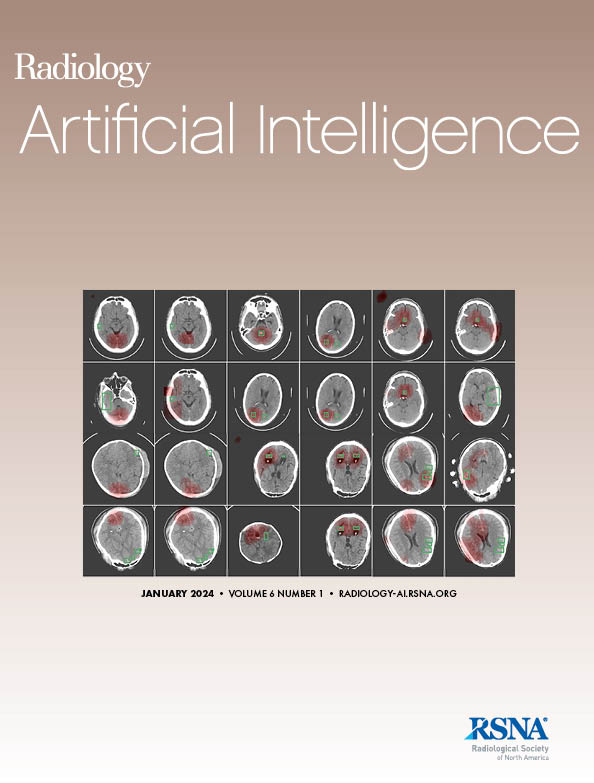Ashkan Moradi, Fadila Zerka, Joeran Sander Bosma, Mohammed R S Sunoqrot, Bendik S Abrahamsen, Derya Yakar, Jeroen Geerdink, Henkjan Huisman, Tone Frost Bathen, Mattijs Elschot
求助PDF
{"title":"Optimizing Federated Learning Configurations for MRI Prostate Segmentation and Cancer Detection: A Simulation Study.","authors":"Ashkan Moradi, Fadila Zerka, Joeran Sander Bosma, Mohammed R S Sunoqrot, Bendik S Abrahamsen, Derya Yakar, Jeroen Geerdink, Henkjan Huisman, Tone Frost Bathen, Mattijs Elschot","doi":"10.1148/ryai.240485","DOIUrl":null,"url":null,"abstract":"<p><p>Purpose To develop and optimize a federated learning (FL) framework across multiple clients for biparametric MRI prostate segmentation and clinically significant prostate cancer (csPCa) detection. Materials and Methods A retrospective study was conducted using Flower FL (Flower.ai) to train a nnU-Net-based architecture for MRI prostate segmentation and csPCa detection using data collected from January 2010 to August 2021. Model development included training and optimizing local epochs, federated rounds, and aggregation strategies for FL-based prostate segmentation on T2-weighted MR images (four clients, 1294 patients) and csPCa detection using biparametric MR images (three clients, 1440 patients). Performance was evaluated on independent test sets using the Dice score for segmentation and the Prostate Imaging: Cancer Artificial Intelligence (PI-CAI) score, defined as the average of the area under the receiver operating characteristic curve and average precision, for csPCa detection. <i>P</i> values for performance differences were calculated using permutation testing. Results The FL configurations were independently optimized for both tasks, showing improved performance at 1 epoch (300 rounds) using FedMedian for prostate segmentation and 5 epochs (200 rounds) using FedAdagrad, for csPCa detection. Compared with the average performance of the clients, the optimized FL model significantly improved performance in prostate segmentation (Dice score, increase from 0.73 ± 0.06 [SD] to 0.88 ± 0.03; <i>P</i> ≤ .01) and csPCa detection (PI-CAI score, increase from 0.63 ± 0.07 to 0.74 ± 0.06; <i>P</i> ≤ .01) on the independent test set. The optimized FL model showed higher lesion detection performance compared with the FL-baseline model (PI-CAI score, increase from 0.72 ± 0.06 to 0.74 ± 0.06; <i>P</i> ≤ .01), but no evidence of a difference was observed for prostate segmentation (Dice scores, 0.87 ± 0.03 vs 0.88 ± 03; <i>P</i> > .05). Conclusion FL enhanced the performance and generalizability of MRI prostate segmentation and csPCa detection compared with local models, and optimizing its configuration further improved lesion detection performance. <b>Keywords:</b> Federated Learning, Prostate Cancer, MRI, Cancer Detection, Deep Learning <i>Supplemental material is available for this article.</i> © RSNA, 2025.</p>","PeriodicalId":29787,"journal":{"name":"Radiology-Artificial Intelligence","volume":" ","pages":"e240485"},"PeriodicalIF":13.2000,"publicationDate":"2025-09-01","publicationTypes":"Journal Article","fieldsOfStudy":null,"isOpenAccess":false,"openAccessPdf":"","citationCount":"0","resultStr":null,"platform":"Semanticscholar","paperid":null,"PeriodicalName":"Radiology-Artificial Intelligence","FirstCategoryId":"1085","ListUrlMain":"https://doi.org/10.1148/ryai.240485","RegionNum":0,"RegionCategory":null,"ArticlePicture":[],"TitleCN":null,"AbstractTextCN":null,"PMCID":null,"EPubDate":"","PubModel":"","JCR":"Q1","JCRName":"COMPUTER SCIENCE, ARTIFICIAL INTELLIGENCE","Score":null,"Total":0}
引用次数: 0
引用
批量引用
Abstract
Purpose To develop and optimize a federated learning (FL) framework across multiple clients for biparametric MRI prostate segmentation and clinically significant prostate cancer (csPCa) detection. Materials and Methods A retrospective study was conducted using Flower FL (Flower.ai) to train a nnU-Net-based architecture for MRI prostate segmentation and csPCa detection using data collected from January 2010 to August 2021. Model development included training and optimizing local epochs, federated rounds, and aggregation strategies for FL-based prostate segmentation on T2-weighted MR images (four clients, 1294 patients) and csPCa detection using biparametric MR images (three clients, 1440 patients). Performance was evaluated on independent test sets using the Dice score for segmentation and the Prostate Imaging: Cancer Artificial Intelligence (PI-CAI) score, defined as the average of the area under the receiver operating characteristic curve and average precision, for csPCa detection. P values for performance differences were calculated using permutation testing. Results The FL configurations were independently optimized for both tasks, showing improved performance at 1 epoch (300 rounds) using FedMedian for prostate segmentation and 5 epochs (200 rounds) using FedAdagrad, for csPCa detection. Compared with the average performance of the clients, the optimized FL model significantly improved performance in prostate segmentation (Dice score, increase from 0.73 ± 0.06 [SD] to 0.88 ± 0.03; P ≤ .01) and csPCa detection (PI-CAI score, increase from 0.63 ± 0.07 to 0.74 ± 0.06; P ≤ .01) on the independent test set. The optimized FL model showed higher lesion detection performance compared with the FL-baseline model (PI-CAI score, increase from 0.72 ± 0.06 to 0.74 ± 0.06; P ≤ .01), but no evidence of a difference was observed for prostate segmentation (Dice scores, 0.87 ± 0.03 vs 0.88 ± 03; P > .05). Conclusion FL enhanced the performance and generalizability of MRI prostate segmentation and csPCa detection compared with local models, and optimizing its configuration further improved lesion detection performance. Keywords: Federated Learning, Prostate Cancer, MRI, Cancer Detection, Deep Learning Supplemental material is available for this article. © RSNA, 2025.
优化联邦学习配置的MRI前列腺分割和癌症检测:模拟研究。
“刚刚接受”的论文经过了全面的同行评审,并已被接受发表在《放射学:人工智能》杂志上。这篇文章将经过编辑,布局和校样审查,然后在其最终版本出版。请注意,在最终编辑文章的制作过程中,可能会发现可能影响内容的错误。目的开发和优化跨多个客户端的联邦学习(FL)框架,用于双参数MRI前列腺分割和临床显著前列腺癌(csPCa)检测。材料和方法回顾性研究使用Flower FL训练基于nnu - net的MRI前列腺分割和csPCa检测架构,数据收集时间为2010年1月至2021年8月。模型开发包括训练和优化局部epoch、联合回合和基于fl的t2加权mri前列腺分割(4名客户,1294名患者)和使用双参数mri检测csPCa(3名客户,1440名患者)的聚合策略。使用分割的Dice评分和前列腺成像:癌症人工智能(PI-CAI)评分在独立测试集上评估性能,PI-CAI评分定义为接受者工作特征曲线下面积和平均精度的平均值,用于csPCa检测。使用排列检验计算性能差异的P值。结果FL配置对两项任务都进行了独立优化,使用FedMedian进行前列腺分割时的1 epoch 300轮和使用FedAdagrad进行csPCa检测时的5 epoch 200轮的性能都有所提高。与客户的平均性能相比,优化后的FL模型显著提高了前列腺分割的性能(Dice评分从0.73±0.06提高到0.88±0.03;P≤0.01)和csPCa检测(PI-CAI评分由0.63±0.07上升至0.74±0.06;P≤0.01)。与FL-基线模型相比,优化后的FL模型具有更高的病变检测性能(PICAI评分从0.72±0.06提高到0.74±0.06;P≤0.01),但前列腺分割无差异(Dice评分:0.87±0.03 vs 0.88±03;P < 0.05)。结论与局部模型相比,FL增强了MRI前列腺分割和csPCa检测的性能和通用性,优化其配置进一步提高了病变检测性能。©RSNA, 2025年。
本文章由计算机程序翻译,如有差异,请以英文原文为准。

 求助内容:
求助内容: 应助结果提醒方式:
应助结果提醒方式:


